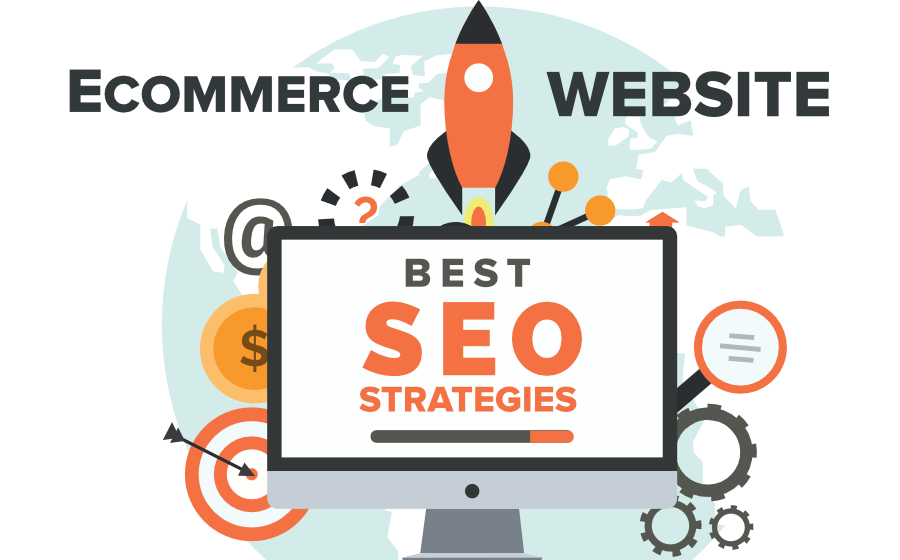Table of Contents

Search Engine Optimization (SEO) is crucial for e-commerce websites looking to attract organic traffic and increase sales. With the ever-growing competition in the online marketplace, optimizing your e-commerce site for search engines is essential to ensure visibility and reach your target audience. In Business Onboarding comprehensive guide, explore 12 actionable tips to improve SEO for e-commerce websites, helping you rank higher in search engine results pages (SERPs) and drive more traffic to your online store.
SEO For ECommerce
Keyword Research and Optimization
Keyword research and optimization are fundamental aspects of SEO for e-commerce websites. It involves identifying relevant keywords and strategically integrating them into your website’s content to improve its visibility in search engine results pages (SERPs).
To conduct keyword research, utilize tools like Google Keyword Planner, SEMrush, or Ahrefs to identify high-volume keywords related to your products or services. Consider factors such as search volume, competition, and relevance to your target audience when selecting keywords.
Once you’ve identified your target keywords, optimize your website’s content by incorporating them into page titles, meta descriptions, headings, product descriptions, and URLs. However, it’s crucial to maintain a natural flow and avoid keyword stuffing, which can negatively impact user experience and SEO performance.
Regularly monitor keyword performance and adjust your strategy accordingly to stay competitive in search rankings. By effectively researching and optimizing keywords, you can attract more organic traffic to your e-commerce website and improve its overall visibility and search engine rankings.
Optimize Product Descriptions
Optimizing product descriptions is crucial for e-commerce websites to attract organic traffic and drive conversions. Start by crafting unique, compelling descriptions that highlight key features, benefits, and use cases of the product. Incorporate relevant keywords naturally within the content to improve search engine visibility and reach your target audience.
Focus on creating informative, concise descriptions that provide valuable information to potential customers while enticing them to make a purchase. Use clear language and avoid jargon or technical terms that may confuse or overwhelm readers. Format descriptions for readability, breaking up text into shorter paragraphs and bullet points for easy scanning.
Additionally, ensure that product descriptions are tailored to the needs and preferences of your target audience, addressing their pain points and offering solutions. By optimizing product descriptions with targeted keywords and persuasive language, you can improve search engine rankings, increase click-through rates, and ultimately boost sales on your e-commerce website.
Create Unique Title Tags and Meta Descriptions
Unique title tags and meta descriptions are essential elements of on-page SEO that directly impact your website’s visibility in search engine results. Title tags should accurately describe the content of each page while incorporating relevant keywords to improve rankings. Keep title tags concise, ideally under 60 characters, to ensure they display properly in search results and capture users’ attention.
Meta descriptions provide a brief summary of the page’s content and serve as a call-to-action to encourage clicks. Write compelling meta descriptions that entice users to click through to your website by highlighting the unique value proposition of the page and addressing users’ search intent. Aim for meta descriptions between 150-160 characters to ensure they display fully in search results and include relevant keywords to improve relevancy and click-through rates.

By crafting unique title tags and meta descriptions for each page of your website, you can optimize your site’s visibility in search results, attract more organic traffic, and improve overall user engagement and conversion rates.
Optimize Image Alt Text
Image alt text, also known as alt attributes or alt tags, is essential for optimizing images on your website for search engines and accessibility purposes. Alt text provides a textual description of an image, allowing search engines to understand the content of the image and improve its visibility in search results. When crafting alt text, aim to provide a concise, descriptive summary of the image, including relevant keywords if applicable.
Avoid stuffing keywords and instead focus on accurately describing the image in a natural, reader-friendly manner. Alt text should be informative, yet succinct, typically ranging from 5 to 15 words. Additionally, prioritize accessibility by using alt text to provide context for visually impaired users who rely on screen readers to navigate the web. By optimizing image alt text, you can enhance your website’s SEO performance, improve user experience, and ensure inclusivity for all visitors.
Improve Site Speed and Performance
Improving site speed and performance is crucial for enhancing user experience and SEO rankings. Start by optimizing images and multimedia files to reduce page load times. Implement browser caching to store frequently accessed resources locally, reducing server requests and improving load times for returning visitors. Minimize HTTP requests by combining and minifying CSS and JavaScript files, streamlining code delivery and rendering.
Utilize content delivery networks (CDNs) to distribute website content across multiple servers worldwide, reducing latency and improving page load times for users across different geographic locations. Enable compression techniques like GZIP to reduce file sizes and accelerate data transfer rates. Lastly, prioritize mobile optimization to ensure fast and seamless browsing experiences for users on smartphones and tablets. By implementing these strategies, you can significantly enhance site speed and performance, leading to improved user satisfaction, higher engagement rates, and better search engine rankings.

Mobile Optimization
Mobile optimization is the process of ensuring that a website is designed and configured to provide an optimal user experience on mobile devices, such as smartphones and tablets. With the increasing prevalence of mobile browsing, mobile optimization has become essential for websites to remain competitive and meet the expectations of mobile users.
Key aspects of mobile optimization include responsive design, which adapts the layout and content of a website to fit different screen sizes and resolutions, ensuring that users can easily navigate and interact with the site on any device. Additionally, mobile optimization involves optimizing page load times, minimizing unnecessary elements, and prioritizing essential content to enhance performance on mobile networks and devices with limited resources.
By prioritizing mobile optimization, websites can improve user engagement, reduce bounce rates, and ultimately increase conversions and revenue. With more users accessing the internet via mobile devices, providing a seamless and enjoyable mobile experience is critical for the success of any website.
Implement Structured Data Markup
Structured data markup, such as Schema.org markup, is a method of adding additional context to your website’s content to help search engines better understand its meaning. By incorporating structured data markup into your e-commerce website, you can provide search engines with specific details about your products, reviews, pricing, and availability. This structured data enables search engines to display rich snippets in search results, enhancing visibility and click-through rates.
To implement structured data markup, you’ll need to identify the appropriate schema types for your content, such as Product, Review, AggregateRating, and Offer schemas. Then, you can add structured data markup directly to your HTML code using JSON-LD, Microdata, or RDFa formats. Ensure that your markup is accurate, relevant, and compliant with search engine guidelines to maximize its effectiveness. By leveraging structured data markup, you can improve the presentation of your e-commerce website in search results and provide users with valuable information that encourages them to click through and explore your products further.
Optimize Internal Linking
Internal linking is a crucial aspect of SEO that involves linking relevant pages within your website to each other. By strategically interlinking pages, you can improve website navigation, distribute link equity, and enhance the overall user experience. Internal linking helps search engines crawl and index your site more effectively, leading to better visibility and higher rankings in search results.
To optimize internal linking, start by identifying key pages and topics on your website that are important for SEO and user engagement. Use descriptive anchor text that includes relevant keywords when linking between pages, providing additional context to search engines and users. Ensure that internal links are natural and add value to the content, avoiding excessive linking or over-optimization. Regularly audit your internal links to identify opportunities for improvement and ensure that they remain up-to-date and relevant to your website’s content and objectives. By optimizing internal linking, you can strengthen your website’s SEO foundation and improve its overall performance in search engine results.
Generate High-Quality Backlinks
Generating high-quality backlinks is essential for improving your website’s authority and visibility in search engine results. Focus on earning backlinks from reputable websites that are relevant to your niche or industry. One effective strategy is to create compelling, shareable content that naturally attracts links from other websites. This could include informative blog posts, infographics, case studies, or industry reports that provide valuable insights or solutions to common problems.
Another approach is to participate in industry-related forums, communities, and social media groups where you can engage with influencers, bloggers, and thought leaders in your field. By contributing valuable insights, answering questions, and sharing your expertise, you can build relationships and earn backlinks from authoritative sources.
Additionally, consider reaching out to relevant websites, bloggers, and journalists to pitch guest posts or collaborate on content projects. Offer unique perspectives, research-backed insights, or exclusive interviews to entice them to link back to your website. Remember to prioritize quality over quantity and focus on building genuine, mutually beneficial relationships to earn high-quality backlinks that positively impact your SEO efforts.
Create Compelling Content
Compelling content captivates, educates, and inspires its audience, eliciting genuine interest and engagement. It speaks directly to the needs, desires, and challenges of the target audience, offering valuable insights, solutions, or entertainment. Compelling content is characterized by its ability to evoke emotions, whether it’s laughter, empathy, or curiosity, forging a meaningful connection with the reader or viewer.
It’s well-researched, authoritative, and thoughtfully crafted, providing unique perspectives or fresh takes on familiar topics. Compelling content is also visually appealing, with attention-grabbing headlines, engaging visuals, and clear, concise messaging. Ultimately, compelling content leaves a lasting impression, prompting action, whether it’s sharing with others, leaving a comment, or making a purchase, and it plays a pivotal role in building brand awareness, credibility, and loyalty.

Optimize for Local SEO
Optimizing for local SEO is crucial for e-commerce businesses with physical stores or those targeting local customers. To improve local search visibility, start by claiming and optimizing your Google My Business listing with accurate business information, including address, phone number, and business hours. Incorporate location-based keywords throughout your website’s content, meta tags, and URL structures to signal relevance to local search queries.
Encourage customers to leave positive reviews and ratings on your Google My Business profile, as these can influence local search rankings and attract more potential customers. Additionally, optimize your website for mobile devices and ensure that your contact information is prominently displayed on every page for easy access.
Consider creating location-specific landing pages or content tailored to local events, attractions, or community initiatives to further boost local relevance and engagement. Finally, leverage local business directories, online maps, and social media platforms to increase your online visibility and reach local audiences effectively. By implementing these strategies, you can enhance your e-commerce site’s local SEO and attract more foot traffic and online sales from your target local market.
Monitor and Analyze Performance
Monitoring and analyzing performance is a critical aspect of maintaining and improving the effectiveness of your e-commerce website’s SEO strategy. By regularly tracking key metrics and analyzing data, you can gain valuable insights into how your site is performing in search engine results and identify areas for optimization.
Using tools like Google Analytics and Google Search Console, you can monitor metrics such as organic traffic, keyword rankings, click-through rates, conversion rates, and user engagement. These metrics provide valuable information about the effectiveness of your SEO efforts, helping you understand which strategies are working well and which areas need improvement.
Analyzing performance data allows you to identify trends, patterns, and opportunities for optimization. For example, you may discover that certain keywords are driving a significant amount of traffic to your site, prompting you to create more content targeting those keywords. Similarly, you may find that certain pages have high bounce rates, indicating a need for improved user experience or content relevance.
By regularly monitoring and analyzing performance data, you can make informed decisions about your SEO strategy, allocate resources effectively, and continuously improve your e-commerce website’s visibility, traffic, and ultimately, its success.
Conclusion
By implementing these 12 tips to improve SEO for your e-commerce website, you can enhance visibility, attract more organic traffic, and ultimately drive sales and revenue. Remember that SEO is an ongoing process, and staying abreast of algorithm updates, industry trends, and user behavior is essential to maintaining your site’s search engine rankings and competitiveness in the online marketplace. With a strategic approach to SEO and continuous optimization efforts, your e-commerce site can achieve long-term success and growth in the digital landscape.



Leave a Reply